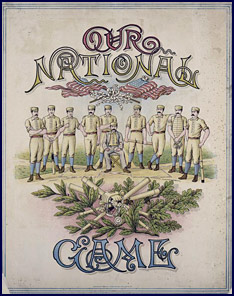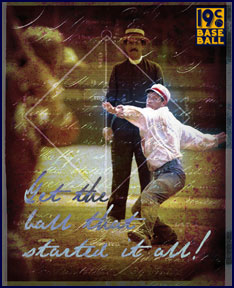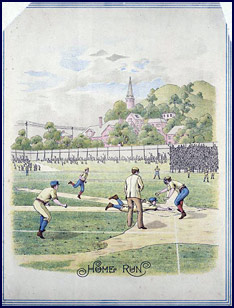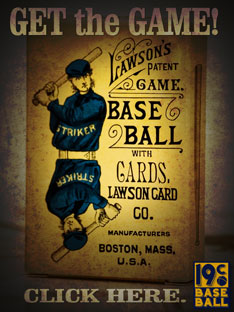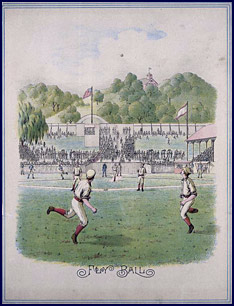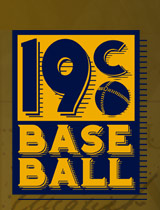History of the Hit Batsman
By Eric Miklich
rom what many consider to be the beginning of organized baseball, 1845, the rules constantly changed and developed into the game that is played today. Many times the change in the playing rules was initiated by the play on the field, as the players constantly found ways to circumvent the rules. There is little doubt that the 1870's and 1880's had the greatest number of rules changes and in fact the batter being hit by a pitched ball was not officially written into the playing rules until 1870. Hitting a batter or being hit by a pitched ball was used by both the pitcher and batter as an important part of the games strategy. The ruling bodies of each baseball league attempted to adjust the rule when it became apparent that the advantage moved toward the pitcher or batter.
The National Association of Base-Ball Players, which began in 1858, did not make mention of a batter being hit by a pitched ball, until the written rules used for the 1870 season. Listed in Beadle's Dime Base Ball Player for the 1870 season in "Rule Second" under the heading "The Pitching Department" was stated the following -
"All balls delivered by the pitcher which are not within the fair reach of the striker, such as balls pitched over the striker's head, or on the ground in front of home base, or pitched over the head of the batsman, or pitched to the side opposite to that which the batsman strikes from, or which hit the striker while he is standing in his proper position, shall be considered unfair balls, and must be called when delivered."
With the pitching distance only 45 feet from the front line of the six foot by six foot pitcher's box to "home base," the distance not defined until 1874, and the increased pitching speed, pioneered by Jim Creighton, hitting a batter with the ball was used as an intimidation technique. The rule was changed to penalize a pitcher with a "ball" in such instances and three called or unfair balls gave the batter his first base. Pitcher's needed to be more selective when throwing at a batter. It is important to note that the first pitch to a batter was not called regardless of it being a strike or ball, from 1870 through 1874.
In 1871, the National Association of Professional Base Ball Players was formed and became the first professional baseball league in America. The same from the previous year was retained but removed the double mention of the ball passing over the batter's head. DeWitt's Base Ball Guide for the 1871 season listed the rule as follows - "All balls pitched over the striker's head, or on the ground in front of the home base, or pitched to the side opposite to that which the batsman strikes from, or which hit the striker while he is standing in his proper position, shall be considered unfair balls, and must be called in the order of their delivery."
For the 1874 season, the batter was required to remain in the "batter's box," which was mandatory to be marked on all playing fields with chalk. The batsman's position was six feet long (from the catcher to the pitcher) by three feet wide. The nearest line to home base was to be one foot and the box was placed three feet in front of and three feet behind the center of the home base. This was done to help aid the umpire in making sure that the batters were not abusing the "straddling the line when striking rule," from 1868 - 1873, and now legally allowed the batters to move freely inside the box when striking. This was also the first year that allowed the pitchers to begin to throw "sidearm."
The rule explaining a "Dead Ball" acknowledged a hit batsman and stated that, "All balls delivered to the bat which shall either touch the striker's bat, without being struck at, or hit the batsman's person while standing within the lines of his position, or which shall hit the person of the umpire, shall be considered as dead balls, and no player shall be put out, base be run, or run be scored on any such ball."
As in 1870, three called "unfair balls" equaled one ball and "three balls" gave the batter his first base. The first pitched ball to the batter was not called. The pitches continually attempted to intimidate batters by throwing at them. Pitchers would also attempt to hit batters to prevent base runners from stealing bases and the batters would obviously attempt to avoid the pitched ball with runners on base.
The final NA season of 1875 listed no change to the rule of a pitched ball hitting a batter. The "Dead Ball" rule was amended involving the umpire and now stated that a "passed ball" that struck the umpire was not considered dead. A passed ball was a pitched ball that was not handled cleanly by the catcher. The catcher could "muff" the ball or allow it to carry past him. A pitched ball that hit the umpire before the catcher had a chance to field it was still considered a dead ball.
With the National Association dissolving after the 1875 season, the National League of Professional Base Ball Clubs began play in 1876. The NL added to the hit batsman under the "Dead Balls" heading in the Constitution and Playing Rules of the National League of Professional Base Ball Clubs guide, published by Reach and Johnson and often mistaken as published by Albert Spalding. The rule stated that,
"All balls delivered to the bat which shall touch the striker's bat without being struck at, or his (the batsman's) person while standing in his position, or which shall hit the person of the umpire - unless it be a passed ball - shall be considered dead balls and shall be so called by the umpire, and no players shall be put out, base be run, or run be scored on any such ball."
The Rules: History of the Hit Batsman Continued ![]()
The Rules of the Game: A Compilation of the Rules of Baseball 1845–1900 ![]()
